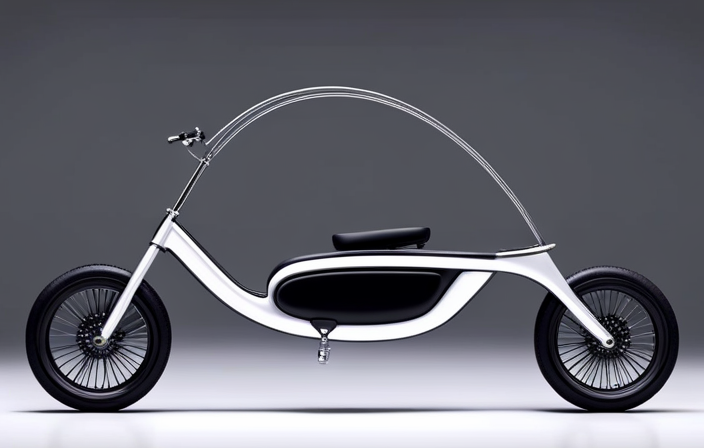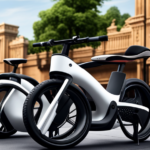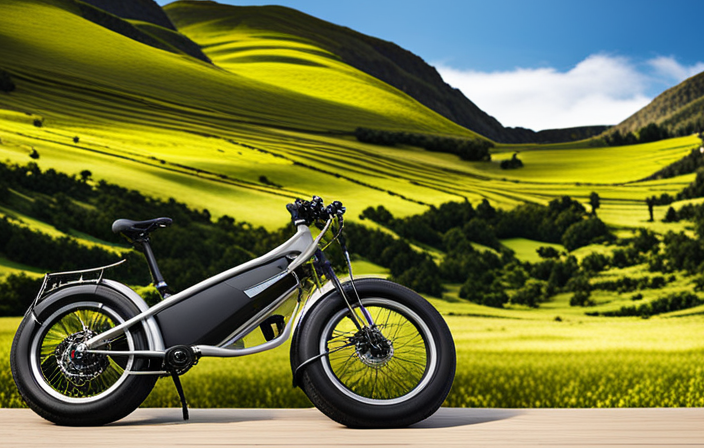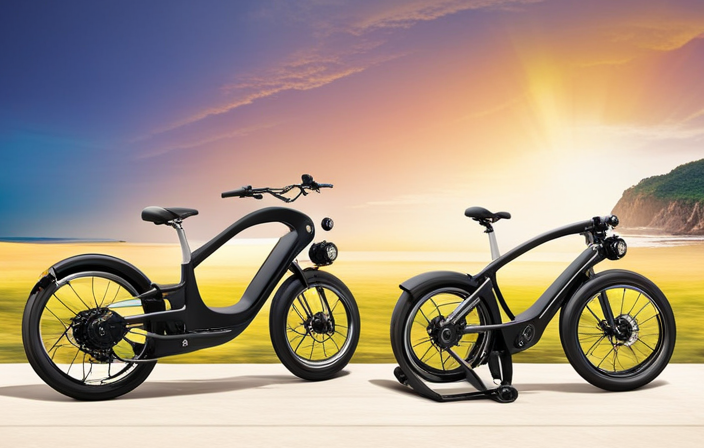I have always been interested in the weight of electric bicycles. It is incredible to see the advancements in technology that have allowed us to have these efficient and environmentally friendly modes of transportation.
But just how heavy are they? In this article, we’ll delve into the components that affect an electric bike’s weight, the importance of weight in electric bikes, and factors to consider when choosing one.
So, if you’re ready to learn more about electric bike weight, let’s dive in!
Key Takeaways
- Electric bikes weigh between 40 to 70 pounds on average, including the battery, motor, frame, and components.
- The weight of an electric bike affects its performance, usability, and maneuverability.
- Lighter electric bikes are easier to transport and have a longer range.
- The weight capacity of an electric bike varies by model and manufacturer, and it is important to consider when carrying heavy items or off-roading.
Components That Affect Weight
One of the components that affects the weight of an electric bike is the battery. The size and capacity of the battery have a significant impact on how heavy the bike will be. Larger batteries, such as those with higher voltage or greater capacity, tend to be heavier.
Another factor that influences the weight of an electric bike is the frame material. Different frame materials, such as aluminum, carbon fiber, or steel, have varying densities and strengths, which can affect the overall weight of the bike. For example, carbon fiber frames are known for their lightweight and strength, making them a popular choice for reducing the weight of electric bikes.
Considering these factors, it becomes clear that both the battery size and the frame material have a crucial role in determining the weight of an electric bike.
Transitioning into the importance of weight in electric bikes, it is essential to understand how these components affect the overall performance and usability of the bike.
Importance of Weight in Electric Bikes
Weight is a crucial factor when considering electric bikes. As someone who has been researching and working with electric bikes for years, I can confidently say that the weight of an electric bike greatly impacts its overall performance and usability.
The weight of an electric bike is primarily determined by its components. The battery, motor, frame, and other parts all contribute to the overall weight. A heavier electric bike may provide more stability and durability, but it can also be more challenging to maneuver and transport.
Additionally, weight plays a role in the maintenance of an electric bike. Heavier bikes may require more effort and cost to maintain, as certain components may wear out faster due to the additional strain.
Considering weight when choosing an electric bike is essential to ensuring a comfortable and enjoyable riding experience. With that being said, let’s delve into the next section about the average electric bike weight.
Average Electric Bike Weight
When it comes to electric bikes, a key consideration is how heavy they are. The weight of an electric bike can greatly impact its performance and usability. Here are four important points to know about the average electric bike weight:
-
Average weight: On average, electric bikes weigh between 40 to 70 pounds. This weight includes the battery, motor, frame, and other components.
-
Maneuverability: Lightweight electric bikes offer better maneuverability, making them easier to handle and navigate through tight spaces or crowded streets.
-
Range: A lighter electric bike requires less power to move, resulting in a longer range. This means you can travel farther on a single charge.
-
Portability: If you plan on transporting your electric bike frequently, a lighter weight makes it easier to lift and store. It also reduces the strain on your vehicle’s carrying capacity.
Considering the average electric bike weight is just one factor to consider when choosing an electric bike.
Factors to Consider When Choosing an Electric Bike
When it comes to choosing an electric bike, there are several key factors to consider.
First and foremost is the usage – whether you plan on using it for daily commuting or off-roading adventures.
Next, you’ll want to take into account the weight capacity of the bike, ensuring it can comfortably support your weight and any additional cargo.
Lastly, portability and storage are important considerations, especially if you have limited space or need to frequently transport your electric bike.
Usage (e.g. commuting, off-roading)
If you’re considering using an electric bike for commuting or off-roading, you’ll be pleased to know that they are versatile and can handle different types of terrain. Electric bikes offer the convenience of commuting without the hassle of traffic, making them a great option for urban dwellers. They also provide an efficient and eco-friendly mode of transportation, saving you money on fuel costs.
However, when it comes to off-roading, electric bikes face some challenges. The rugged terrain and steep slopes can put a strain on the motor and battery, requiring a more powerful electric bike.
Transitioning to the next section, it’s important to consider the weight capacity of an electric bike, as it directly impacts its performance and durability.
Weight Capacity
The weight capacity of an e-bike affects how much gear you can carry. It’s important to consider the weight capacity when choosing an electric bike, especially if you plan on carrying heavy items or going on long trips. Most e-bikes have a weight capacity ranging from 250 to 400 pounds, but it can vary depending on the model and manufacturer. To give you a better idea, here’s a table showing the weight capacity of three popular e-bike brands:
| Brand | Weight Capacity (lbs) |
|---|---|
| Brand A | 300 |
| Brand B | 350 |
| Brand C | 400 |
When it comes to weight distribution, it’s important to evenly distribute the weight on the e-bike to maintain stability and performance. The weight should be centered and balanced, with heavier items placed closer to the bike’s center of gravity. This ensures better handling and control while riding. Now that we’ve covered weight capacity and distribution, let’s move on to the next section about portability and storage.
Portability and Storage
You should consider how portable and easy to store an e-bike is before making a purchase. When it comes to portability challenges, here are four important factors to keep in mind:
-
Weight: A heavier e-bike can be more difficult to transport, especially if you need to carry it up stairs or lift it into a vehicle.
-
Folding Mechanism: Some e-bikes have a folding design, making them easier to store in small spaces or transport in a car.
-
Size: Consider the dimensions of the e-bike when folded and unfolded, ensuring it will fit in your desired storage space.
-
Accessories: Look for e-bikes that come with storage solutions like racks or baskets, providing convenient options for carrying your belongings.
Taking into account these portability challenges, let’s now explore lightweight electric bike options that offer easy transportation and storage capabilities.
Lightweight Electric Bike Options
Looking for a lightweight electric bike? Check out these options. When it comes to electric bikes, the weight of the bike itself can greatly impact its portability and ease of use. To help you find a lightweight option, I’ve compiled a list of electric bikes that feature a lightweight frame and battery weight. Take a look at the table below for some top choices:
| Electric Bike Model | Frame Material | Battery Weight |
|---|---|---|
| Model A | Aluminum | 5 lbs |
| Model B | Carbon Fiber | 4.5 lbs |
| Model C | Titanium | 3.8 lbs |
| Model D | Steel | 6 lbs |
| Model E | Aluminum | 4 lbs |
These bikes are designed to prioritize weight reduction without compromising on performance. With their lightweight frames and batteries, they offer a great balance between portability and power. Now, let’s move on to the next section where we’ll explore heavy-duty electric bikes.
Heavy-Duty Electric Bikes
If you’re in need of a sturdy and durable option, consider checking out these heavy-duty electric bikes. They are built to handle tough terrains and provide a reliable mode of transportation.
Here are some features and advantages of heavy-duty electric bikes:
-
Powerful Motors: Heavy-duty electric bikes are equipped with powerful motors that can handle steep inclines and rough surfaces with ease. This ensures a smooth and effortless ride, even in challenging conditions.
-
Enhanced Suspension: These bikes often come with advanced suspension systems that absorb shocks and vibrations, providing a comfortable and stable ride. This is especially beneficial when riding on uneven or bumpy surfaces.
-
Robust Frame: Heavy-duty electric bikes are constructed with strong and durable frames, allowing them to withstand heavy loads and rough usage. This makes them ideal for carrying cargo or for riders who prefer a more rugged and durable option.
-
Extended Battery Life: Due to their larger size and capacity, heavy-duty electric bikes typically have longer battery life. This means you can go on longer rides without worrying about running out of power.
Tips for Managing Electric Bike Weight
One way to effectively manage the weight of a heavy-duty electric bike is by distributing the load evenly across the bike’s frame. This not only helps with maintaining balance and stability but also reduces the strain on specific parts of the bike.
When it comes to managing the battery weight, it is advisable to position the battery as low and as centrally as possible. This helps in maintaining a lower center of gravity, making the bike easier to handle and maneuver.
Additionally, using lightweight materials for the bike’s components, such as aluminum or carbon fiber, can help reduce overall weight.
By implementing these strategies, riders can optimize weight distribution and improve the overall performance of their heavy-duty electric bikes.
Transitioning into the subsequent section about the pros and cons of lighter electric bikes, it’s important to consider the trade-offs between weight and other factors that impact the bike’s performance.
Pros and Cons of Lighter Electric Bikes
Lighter electric bikes have the advantage of being more maneuverable and easier to handle. They offer several benefits over their heavier counterparts. These advantages include:
- Improved agility: Lighter electric bikes are easier to control, making them ideal for navigating tight corners and crowded streets.
- Better portability: With less weight to carry, it becomes easier to transport the bike when needed, whether it’s on public transportation or in the trunk of a car.
- Enhanced battery life: The reduced weight puts less strain on the battery, allowing for longer rides and increased range.
- Quicker acceleration: Lighter electric bikes tend to accelerate faster, providing a more responsive and enjoyable riding experience.
However, there are also some disadvantages to consider with lighter electric bikes. For instance, they may not handle rough terrains or steep hills as well as heavier models. Additionally, they might not offer as much stability at high speeds. Despite these drawbacks, many riders find the advantages of lighter electric bikes outweigh the disadvantages.
Moving on to the pros and cons of heavier electric bikes…
Pros and Cons of Heavier Electric Bikes
Now that we have explored the pros and cons of lighter electric bikes, let’s turn our attention to the benefits and drawbacks of heavier electric bikes.
While lighter electric bikes offer ease of maneuverability and convenience, heavier bikes have their own advantages. One of the main benefits of a heavier electric bike is its stability. The added weight provides a more grounded and stable ride, especially when navigating rough terrains. Additionally, the extra weight can enhance the bike’s ability to handle heavier loads, making it suitable for transporting groceries or other items.
However, it’s important to consider the portability concerns of a heavier electric bike, as they can be more challenging to lift or transport. Another factor to consider is the impact on battery life. The added weight may put more strain on the battery, potentially reducing its overall lifespan.
As we delve into choosing the right weight for your needs, let’s explore the various factors that should be taken into consideration.
Choosing the Right Weight for Your Needs
When it comes to choosing the right electric bike for your needs, there are several key points to consider.
First, you’ll want to assess your riding style and goals. Are you looking for a bike for daily commuting, off-road adventures, or leisurely weekend rides?
Next, it’s important to try out different models to see which one feels the most comfortable and suits your riding preferences.
Finally, think about any future upgrades or modifications you might want to make, such as adding a cargo rack or upgrading the battery.
Assessing Your Riding Style and Goals
If you’re not sure which electric bike to choose, consider assessing your riding style and goals. Your riding technique and battery capacity are two important factors to consider.
If you prefer a more aggressive riding style, with high speeds and frequent acceleration, you may want to opt for an electric bike with a larger battery capacity. This will ensure that you have enough power to support your riding style and cover longer distances.
On the other hand, if you mainly use your electric bike for commuting or leisurely rides, a smaller battery capacity might be sufficient. By assessing your riding style and goals, you can determine the appropriate battery capacity that meets your needs.
Once you have this information, you’ll be better prepared to try out different models and find the perfect electric bike for you.
Trying Out Different Models
After assessing your riding style and goals, it’s time to try out different models to find the perfect electric bike for you.
When trying out different electric bike models, it’s important to consider the various usage types and battery capacity.
Usage types refer to the intended purpose of the bike, whether it’s for commuting, mountain biking, or leisurely rides. Each usage type may require different features and specifications.
Battery capacity is another crucial factor to consider. It determines how far you can ride on a single charge. Higher battery capacity means longer rides without needing to recharge.
By testing out different models with varying usage types and battery capacities, you can get a better understanding of what suits your needs and preferences.
This will help you make an informed decision when considering future upgrades or modifications.
Considering Future Upgrades or Modifications
To make sure your electric bike meets your evolving needs, consider possible future upgrades or modifications. Investing in a bike that can be easily upgraded will allow you to enhance its performance as technology advances.
One potential future upgrade is the battery. As battery technology improves, you might want to upgrade to a higher capacity battery, giving you longer ride times and increased range.
Another area for potential improvement is the motor. Upgrading to a more powerful motor can provide you with greater speed and acceleration.
Additionally, consider performance modifications such as upgrading the brakes or adding suspension for a smoother ride.
Frequently Asked Questions
Can the weight of an electric bike affect its performance?
The weight of an electric bike can indeed affect its performance. Weight distribution plays a crucial role in how the bike handles and maneuvers. Additionally, a heavier bike may have a slower acceleration compared to a lighter one.
Are there any safety concerns associated with heavier electric bikes?
There are safety concerns associated with heavier electric bikes. Exceeding weight restrictions can affect the bike’s stability and maneuverability, potentially leading to accidents. It’s important to follow the manufacturer’s recommendations for maximum weight capacity to ensure safe riding.
How does the weight of an electric bike affect its range or battery life?
The weight of an electric bike can affect its speed and durability. A heavier bike may have a reduced range or battery life due to the increased strain on the motor and battery.
Can the weight of an electric bike impact its maneuverability and ease of handling?
When it comes to maneuverability and ease of handling, the weight of an electric bike can have a significant impact. Weight limitations should be considered, especially for uphill riding, as heavier bikes can be more challenging to control.
Are there any specific weight restrictions or limitations when using an electric bike?
When using an electric bike, there are weight restrictions and limitations to consider. These may vary depending on the specific model and manufacturer. It’s important to consult the bike’s manual or contact the manufacturer for specific guidelines.
Conclusion
After exploring the components that affect the weight of electric bikes and understanding the importance of weight, it is clear that choosing the right weight for your needs is crucial.
Whether you opt for a lightweight electric bike for easy maneuverability or a heavier one for added stability, it all depends on your preferences and intended usage.
Just like a feather effortlessly gliding through the air, finding the perfect balance in weight will allow you to effortlessly glide through your electric bike journeys.
















